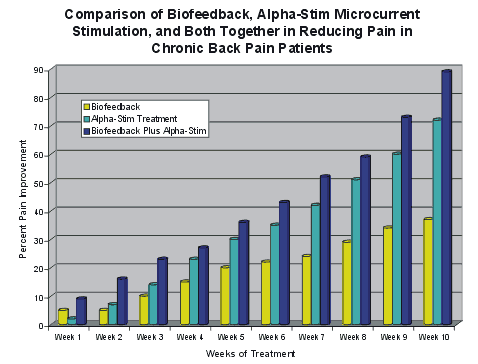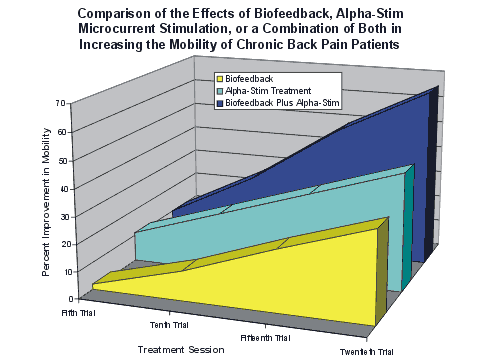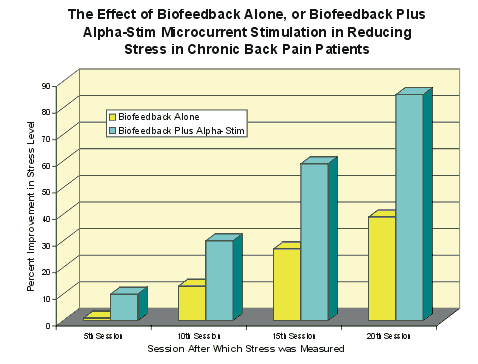Biofeedback and Electromedicine Reduce the Cycle of Pain Spasm Pain in Low Back Patients
Zimmerman, Stephen I, & Lerner, Fred N. Biofeedback and Electromedicine Reduce the Cycle of Pain Spasm Pain in Low Back Patients. Medical Electronics, 117:108-120, June 1989. Doctoral dissertation (SZ), City University Los Angeles, 284 pages, 1987. Download Article
45 subjects were selected from those who responded to public notices. All were required to obtain a physician’s referral for erector spinae spasms at a level between the third and fifth lumbar vertebrae, with associated low back pain. Subjects were excluded if they were pregnant, had a history of heart disease, psychosis, diabetes, epilepsy, drug or alcohol abuse, or were on pain medications or other rehabilitative therapy during the time of the study. They were then randomly divided into 3 treatment groups of Alpha-Stim electrical stimulation and EMG biofeedback (Group I), biofeedback alone (Group II), or Alpha-Stim electrical stimulation alone (Group III). 1 subject in Group II, and 2 in Group III failed to complete the study. 20 treatments were given, twice a week for 30 minute sessions, to the remaining 42 subjects of which 26 (61.9%) were female and 16 (38.1%) were male, ranging in age from 23 to 62 years old (mean of 41.1 years). Each Group started the study with an essentially equal relevant history of approximately 16.4 months. There were no significant differences in any of the 3 groups in sex, education level, occupational level, injury site and duration of pain, or socioeconomic class. The only significant group difference was in age between Group I with a mean of 35.7 years, and Group II with a mean of 44.6 years. Measures used to assess treatment outcome were trunk mobility evaluation, Subjective Units of Disturbance (SUDS), daily pain record cards for home recording, electromyogram (EMG) microvoltage readings and pre and post-treatment Minnesota Multiphasic Personality Inventory (MMPI).
All Groups improved significantly in their trunk mobility. Daily pain cards also improved across all groups, however, it was evident by the conclusion of the study that Groups I and III who received electrical stimulation noted a greater reduction in perceived pain than the biofeedback subjects in Group II. SUDS, a measure of how their physical symptoms resulted in psychological distress was measured on a 0 (no disturbance) to 100 (extreme disturbance) scale. Group I subjects demonstrated the best improvement in SUDS which were reduced from an initial mean of 89 to a final of 8.3, and Group III reported a greater improvement in SUDS than Group II. All Groups exhibited significant and equivalent reductions in their EMG after the first treatment session. All Groups also exhibited a decrease in their level of psychological distress as evidenced by changes in the MMPI. Clinically significant decrements of impairment were found to exist on 13 of 17 MMPI subscales: Lie, Faking Bad, Sophisticated Liar, Hypochondriasis, Depression, Hysteria, Psychopathic Deviant, Paranoid, Psychasthenia, Schizophrenia, Caudality, Low Back Pain, and Somatic Complaints. The findings denote a shift from individuals who present themselves, in the aggregate, as displaying clinically significant effects which connote persons who are overly sensitive towards others, with an increased emphasis upon their own symptomatology and decreased expectancy that others will be supportive and empathetic, while at the same time use physical complaints to focus attention upon themselves so as to manipulate others, towards more open and accepting individuals who experience less stressful and more adaptive patterns of functioning.
The authors concluded that the results suggest that the effects of each treatment modality were cumulative, or additive to the other mode of treatment, and more effective than each procedure used alone, with the exception of EMG findings. No side negative effects were reported.
The graph shows the percent improvement in pain for the biofeedback group alone, for the Alpha-Stim group alone, and for the biofeedback plus Alpha-Stim microcurrent stimulation group. It can be seen that the greatest improvement for the biofeedback group was 37%, for the Alpha-Stim group was 71% while the improvement of the combined treatment group was 89%.
The graph shows the mobility gain from biofeedback alone and shows the potentiating effect of Alpha-Stim when used with biofeedback therapy. It can be seen that with 20 sessions of biofeedback, there was a 22% gain in back mobility, the group that had Alpha-Stim microcurrent stimulation gained 33%, whereas for the group that had 10 biofeedback sessions, alternated with 10 Alpha-Stim treatments, the gain in mobility was 64%.
The graph shows that while biofeedback therapy reduced the patients’ perception of personal psychological distress by 39% by the end of the study the group receiving both biofeedback and Alpha-Stim microcurrent stimulation perceived an 85% drop in their level of psychological distress.



